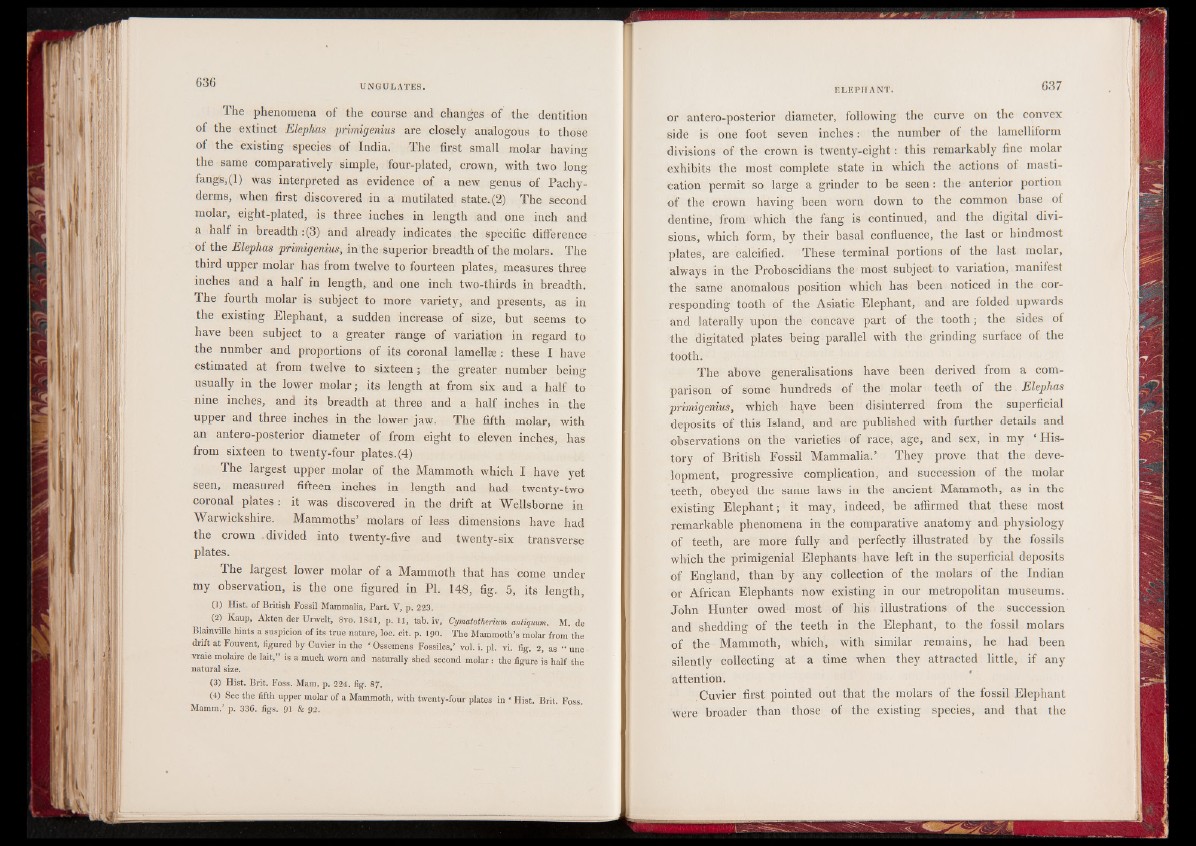
The phenomena of the course and changes of the dentition
of the extinct Elephas primigenius are closely analogous to those
of the existing species of India. The first small molar having
the same comparatively simple, four-plated, crown, with two long
fangs,(1) was interpreted as evidence of a new genus of Pachyderms,
when first discovered in a mutilated state. (2) The second
molar, eight-plated, is three inches in length and one inch and
a half in breadth :(3) and already indicates the specific difference
of the Elephas primigenius, in the superior breadth of the molars. The
third upper molar has from twelve to fourteen plates, measures three
inches and a half in length, and one inch two-thirds in breadth.
The fourth molar is subject to more variety, and presents, as in
the existing Elephant, a sudden increase of size, but seems to
have been subject to a greater range of variation in regard to
the number and proportions of its coronal lamellae : these I have
estimated at from twelve to sixteen; the greater number being
usually in the lower molar; its length at from six and a half to
nine inches, and its breadth at three and a half inches in the
upper and three inches in the lower jaw. The fifth molar, with
an antero-posterior diameter of from eight to eleven inches, has
from sixteen to twenty-four plates. (4)
The largest upper molar of the Mammoth which I have yet
seen, measured fifteen inches in length and had twenty-two
coronal plates: it was discovered in the drift at Wellsborne in
Warwickshire. Mammoths’ molars of less dimensions have had
the crown divided into twenty-five and twenty-six transverse
plates.
The largest lower molar of a Mammoth that has come under
my observation, is the one figured in PI. 148, fig. 5, its length,
(1) Hist, of British Fossil Mammalia, Part. V, p. 223.
(2) Kaup, Akten der Urwelt, 8vo. 1841, p. 11, tab. iv, Cymatotherium antiquum. M. de
Blamville hints a suspicion of its true nature, loc. cit. p. 190. The Mammoth’s molar from the
drift at Fouvent, figured by Cuvier in the ‘Ossemens Fossiles,’ vol. i. pi. vi. fig. 2, as “ une
vraie molaire de lait,” is a much worn and naturally shed second molar:natural size. the figure is half the
(3) Hist. Brit. Foss. Mam. p. 224. fig. 87.
(4) See the fifth upper molar of a Mammoth, with twenty-four plates in ' Hist. Brit. Foss.
Mamm.’ p. 33fi. figs. 91 & 92.
or antero-posterior diameter, following the curve on the convex
side is one foot seven inches: the number of the lamelliform
divisions of the crown is twenty-eight: this remarkably fine molar
exhibits the most complete state in which the actions of mastication
permit so large a grinder to be seen: the anterior portion
of the crown having been worn down to the common base of
dentine, from which the fang is continued, and the digital divisions,
which form, by their basal confluence, the last or hindmost
plates, are calcified. These terminal portions of the last molar,
always in the Proboscidians the most subject to variation, manifest
the same anomalous position which has been noticed in the corresponding
tooth of the Asiatic Elephant, and are folded upwards
and laterally upon the concave part of the tooth; the sides of
the digitated plates being parallel with the grinding surface of the
tooth.T
he above generalisations have been derived from a comparison
of some hundreds of the molar teeth of the Elephas
primigenius, which have been disinterred from the superficial
deposits of this Island, and are published with further details and
observations on the varieties of race, age, and sex, in my ‘History
of British Fossil Mammalia.’ They prove that the development,
progressive complication, and succession of the molar
teeth, obeyed the same laws in the ancient Mammoth, as in the
existing Elephant; it may, indeed, be affirmed that these most
remarkable phenomena in the comparative anatomy and physiology
of teeth, are more fully and perfectly illustrated by the fossils
which the primigenial Elephants have left in the superficial deposits
of England, than by any collection of the molars of the Indian
or African Elephants now existing in our metropolitan museums.
John Hunter owed most of his illustrations of the succession
and shedding of the teeth in the Elephant, to the fossil molars
of the Mammoth, which, with similar remains, he had been
silently collecting at a time when they attracted little, if any
attention.
.Cuvier first pointed out that the molars of the fossil Elephant
Were broader than those of the existing species, and that the